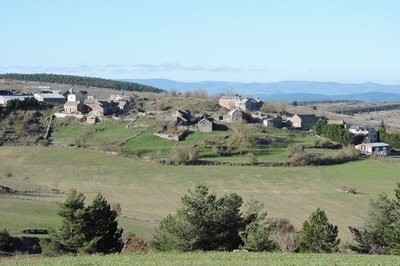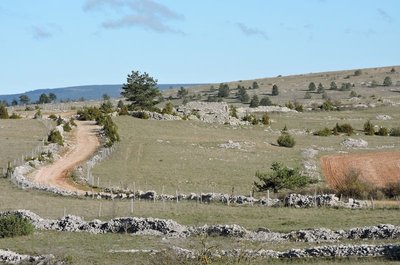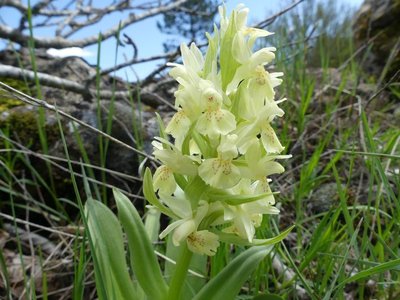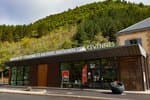
Sauveterre
3 points of interest

Vue sur le village de Sauveterre - © OTGCC nc  Geology
GeologyA hamlet on a former volcano
The hamlet was built on the remains of a former volcano, which has been worn down by erosion. Sauveterre lies on part of the large volcanic chain of the Languedoc. The depression under the hamlet has particularly fertile soil. It has been put to good agricultural use for a long time. Today, 3 GAEC (jointly run farms) share the land around the village. Sheep breeding (for milk or meat) dominates. Flocks are 500 to 700 heads in size.
Chemin des bergers - © OTGCC nc  History
HistorySauveterre
Built on a volcanic hillock, Sauveterre hamlet sits at the crossroads of several historic routes. Here, the grande draille (main drovers’ road), a transhumance route linking the garrigues or arid shrubland of Languedoc with the summer pastures of the Aubrac plateau, crosses an ancient track linking the Vivarais with Lower Gévaudan and the Rouergue (today’s GR44 hiking path). In the 12th century, the Prior of Sainte Enimie, the local lord, declared the hamlet a salvetat. A salvetat was an area protected by God’s Peace, meaning that all violence was forbidden within its perimeter, delineated by markers. It was a place of refuge for fugitive serfs, peasants with debts, offenders or petty criminals, under the protection of the Church. After one year, they were absolved on condition of settling here, and were give some land to cultivate. This policy rehabilitated uncultivated or abandoned parcels of land. Some dwellings were built near a source of water, then a little fort to protect the travellers and a chapel dedicated to St Ferréol (Ferreolus): from 1250 onwards, Sauveterre slowly came into being.
Orchis sureau - Nathalie Thomas  Flora
FloraVast open spaces
Generally speaking, Causse soils do not retain water (except in the rare clay areas), which favours a spontaneously xerophile flora, meaning that it is resistant to drought. The Causse economy is essentially pastoral and has created a whole range of open spaces – from crops to pastureland to sheep enclosures – as well as wooded zones, which encourages wild flora. The vast grasslands around you show their colours in the summer months with a wealth of flowers. For those interested in botany, every step is a marvel in spring!
Description
- Leave the road and take the path on your left for 1.2 km.
- Turn left onto the path that goes downhill and around the depression (sinkhole).
- As you arrive at the tarred surface, take the road on your left that goes up into the village and back to your starting-point.
- Departure : Sauveterre village
- Arrival : Sauveterre village
- Towns crossed : Gorges du Tarn Causses
Forecast
Altimetric profile
Recommandations
Information desks
Tourism office Cévennes Gorges du Tarn, Sainte-Enimie
village, 48210 Sainte-Enimie
This office is part of the National Park's associated tourist-information network, whose mission is to provide information on, and raise awareness of, the sites and events as well as the rules that must be observed in the National Park's central zone.
Tourism'house and national Parc at Florac
Place de l'ancienne gare, N106, 48400 Florac-trois-rivières
This office is part of the National Park's associated tourist-information network, whose mission is to provide information on, and raise awareness of, the sites and events as well as the rules that must be observed in the National Park's central zone.
On site: exhibitions, video projections, events and shop Open year-round
Access and parking
Parking :
Calculateur d'itinéraire Lio
Utilisez le calculateur liO pour organiser votre trajet en région Occitanie.
Autres régions
Calculez votre itinéraire en Auvergne Rhône Alpes sur Oùra
Biodiversité autour de l'itinéraire
Source


Report a problem or an error
If you have found an error on this page or if you have noticed any problems during your hike, please report them to us here:


